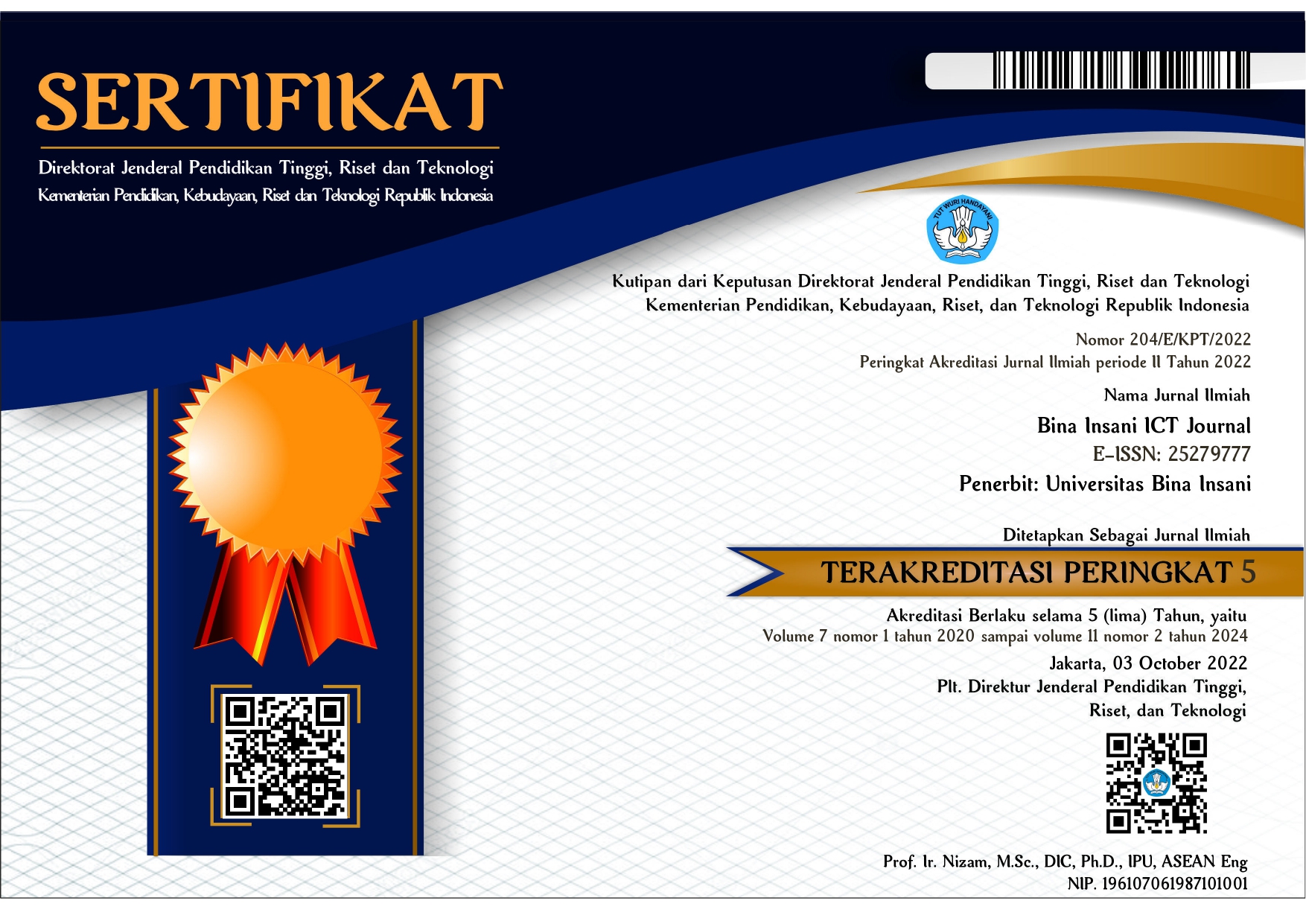Perancangan ERP S4Hana Cloud Pada Modul Material Management Menggunakan Metode SAP Active
Abstract
Abstrak: Implementasi dan Migrasi suatu project Enterprise Resources Planing (ERP) memerlukan banyak sarana dan prasarana pendukung untuk bisa memastikan sukses sebuah project. Dukungan dari top level dan user menjadi kunci utama dalam keberhasilan sebuah project implementasi ERP. Salah satu trend ERP yang banyak digunakan di perusahan skala menengah dan atas adalah ERP dari SAP. System analysis program (SAP) S/4 Hana Cloud atau S4HC merupakan SAP Business Suite berbasis Cloud. Penelitian ini memberikan gambaran menyeluruh mengenai tahapan tahapan-tahapan dalam migrasi sistem ERP legacy ke dalam sistem ERP yang berbasi cloud yang memberikan kemudahan dalam sisi teknis dan operasional. Metode yang digunakan adalah metode SAP Active yang menggunakan enam tahapan. Tulisan ini menampilkan tahapan-tahapan penting yang timbul pada saat migrasi dengan metode SAP Active, sehingga bisa memberikan suatu pemahaman bagaimana memulai dan menyelesaikan sebuah project implementasi dan migrasi sistem SAP ERP Central Component (ECC) ke S4HC. Hasil dari penelitian ini adalah berupa tahapan migrasi pada modul material management dimulai dari tahapan discover, prepare, explore, realize, and deploy dan run. Proses migrasi dari SAP ECC menjadi S4HC merupakan proses yang panjang dan diperlukan keterlibatan dari team yang sudah terlatih dan adanya dukungan dari manajemen dan semua user yang terlibat.Kata kunci: metode SAP active, modul material management, perancangan ERP S4Hana cloud
Abstract: The implementation and migration of an Enterprise Resources Planning (ERP) project requires many supporting facilities and infrastructure to ensure the success of a project. Support from top level and users is the main key in the success of an ERP implementation project. One of the ERP trends that is widely used in middle and upper-scale companies is ERP from SAP. System analysis program (SAP) S/4 Hana Cloud or S4HC is a Cloud-based SAP Business Suite. This research provides a comprehensive overview of the stages in the migration of legacy ERP systems to cloud-based ERP systems that provide convenience in term of technical and operational aspects. The method used is the SAP Active method which uses six stages. This paper presents the important stages that arise during the migration with the SAP Active method, so that it can provide an understanding of how to start and complete a project implementation and migration of the SAP ERP Central Component (ECC) system to S4HC. The results of this study are in the form of migration stages in the material management module starting from the discover, prepare, explore, realize, deploy and run stages. The migration process from SAP ECC to S4HC is a long process and requires the involvement of a trained team and support from management and all users involved.
Keywords: S4Hana cloud ERP design, material management module, SAP active method
References
[1] F. Y. Wohon, Analisa Pengaruh Percepatan Durasi Pada Biaya Proyek Menggunakan Program Microsoft Project 2013 (Studi Kasus : Pembangunan Gereja GMIM Syaloom Karombasan). Jurnal Teknik Sipil, vol.3, no.2, pp.141-150, 2015.
[2] D. A. Almajali, R. Masa’deh, A. Tarhini, Antecedents of ERP systems implementation success: a study on Jordanian healthcare sector. Journal of Enterprise Information Management, vol.29, pp.549–565, 2016.
[3] A. Boza, L. Cuenca, R. Poler, Z. Michaelides, The interoperability force in the ERP field. Enterprise Information Systems, vol. 9, pp. 257–278, 2015.
[4] S. Bernal. Determination of Critical Success Factors in Implementing an ERP System: A Field Study in Mexican Enterprises, 2007.
[5] Z. Moh, D Ali Smadi, The Operational Benefits of Enterprise Resource Planning (ERP): A Case Study on Food Processing and Manufacturing Companies in Jordan. International Journal of Business and Social Science, vol. 7, pp. 21-38, 2016.
[6] K. Khanna, Choosing an Appropriate ERP Implementation Strategy. IOSR Journal of Engineering, vol. 2, pp. 478-483, 2012.
[7] A. Leon, “Enterprise Resource Planningâ€, Tata McGraw-Hill, India, 2009.
[8] W. P. Mwakyusa, K. Kavuta, Enhancing ERP Adoption in Government Training Institutions for Effective Financial Management: A Case of Tanzania Institute of Accountancy (TIA). Core.Ac.Uk, 2020, (available at https://core.ac.uk/download/pdf/234696334.pdf).
[9] M. D. E. L. C. Gutiérrez-diez, L. C. Piñón-howlet, A. L. Sapién-aguilar, ERP´s Implementation Methodologies Review. International Review of Management and Business Research, vol. 6, pp. 939-948, 2017.
[10] M. H. Hilman, F. Setiadi, I. Sarika, J. Budiasto, R. Alfian, Comparative Study Of Erp Implementation Methodology Case Study: Accelerated Sap Vs Dantes & Hasibuan Methodology. Jurnal Sistem Informasi, vol. 8, no. 8, 2013.
[11] L. lau. Managing Business with SAP: Planning, Implementation and Evaluation, Estados Unidos. Idea Group Publishing, 2005.
[12] Accelerated SAP roadmap picture, available online on https://sapfidocz.wordpress.com/tag/accelerated-sap/ accessed on August 11, 2021.
[13] Ganesh Neupane A Project Plan For The Implementation Of S/4hana Thesis Centria University Of Applied Sciences Industrial Management. (2020).
[14] P Osterhaus,. ASAP Methodology vs. SAP Activate. Understanding the differences: Protera technologies. Available: https://www.protera.com/sap-blog/asap-methodology-vs-sap-activate/, accessed 12 August 2021.
[15] SAP. Transition to SAP S/4HANA, Volume Q4. Available: https://support.sap.com/content/dam/SAAP/SAP_Activate/S4H_155.pdf, accessed 12 August 2021.
[16] K. Falgenti, S. Mai, Chandra, 968-2259-3-Pb. Unit Research and Knowledge, School of Business and Management - Institut Teknologi Bandung (SBM-ITB), vol. 271, no. 13, pp. 271-289, 2014.
[17] F. Ananda, R. D. Putra, V. S. Hendrastyo, Kesuksesan Implementasi System Application Product (Sap) Studi di PT. Semen Padang. Jurnal Pundi, vol. 1, 2017, doi:10.31575/jp.v1i1.4.
[18] Ilham/Univeritas islam indonesia. ERP SAP. Implementasi ERP SAP dalam Pembuatan Report Demografi Organisasi (Studi Kasus PT. Krakatau Steel (Persero) Tbk.), vol. 23, no. 55, 2017.
[19] R. Maulidina, N. A. Rizki, R. S. Dewi, Perencanaan dan Implementasi SAP pada PT XYZ dengan Menggunakan Metode Accelerated SAP (ASAP). JURIKOM (Jurnal Riset Komputer), vol. 7, no. 83, 2020.
[20] P. M. Jannah, L. W. Suwarsono, P. F. Alam, Perancangan Enterprise Resource Planning Modul Benefits Aplikasi SAP dengan Metode SAP Activate Pada PT. XYZ. JuTISI, vol. 4, pp. 292-304, 2018.
[2] D. A. Almajali, R. Masa’deh, A. Tarhini, Antecedents of ERP systems implementation success: a study on Jordanian healthcare sector. Journal of Enterprise Information Management, vol.29, pp.549–565, 2016.
[3] A. Boza, L. Cuenca, R. Poler, Z. Michaelides, The interoperability force in the ERP field. Enterprise Information Systems, vol. 9, pp. 257–278, 2015.
[4] S. Bernal. Determination of Critical Success Factors in Implementing an ERP System: A Field Study in Mexican Enterprises, 2007.
[5] Z. Moh, D Ali Smadi, The Operational Benefits of Enterprise Resource Planning (ERP): A Case Study on Food Processing and Manufacturing Companies in Jordan. International Journal of Business and Social Science, vol. 7, pp. 21-38, 2016.
[6] K. Khanna, Choosing an Appropriate ERP Implementation Strategy. IOSR Journal of Engineering, vol. 2, pp. 478-483, 2012.
[7] A. Leon, “Enterprise Resource Planningâ€, Tata McGraw-Hill, India, 2009.
[8] W. P. Mwakyusa, K. Kavuta, Enhancing ERP Adoption in Government Training Institutions for Effective Financial Management: A Case of Tanzania Institute of Accountancy (TIA). Core.Ac.Uk, 2020, (available at https://core.ac.uk/download/pdf/234696334.pdf).
[9] M. D. E. L. C. Gutiérrez-diez, L. C. Piñón-howlet, A. L. Sapién-aguilar, ERP´s Implementation Methodologies Review. International Review of Management and Business Research, vol. 6, pp. 939-948, 2017.
[10] M. H. Hilman, F. Setiadi, I. Sarika, J. Budiasto, R. Alfian, Comparative Study Of Erp Implementation Methodology Case Study: Accelerated Sap Vs Dantes & Hasibuan Methodology. Jurnal Sistem Informasi, vol. 8, no. 8, 2013.
[11] L. lau. Managing Business with SAP: Planning, Implementation and Evaluation, Estados Unidos. Idea Group Publishing, 2005.
[12] Accelerated SAP roadmap picture, available online on https://sapfidocz.wordpress.com/tag/accelerated-sap/ accessed on August 11, 2021.
[13] Ganesh Neupane A Project Plan For The Implementation Of S/4hana Thesis Centria University Of Applied Sciences Industrial Management. (2020).
[14] P Osterhaus,. ASAP Methodology vs. SAP Activate. Understanding the differences: Protera technologies. Available: https://www.protera.com/sap-blog/asap-methodology-vs-sap-activate/, accessed 12 August 2021.
[15] SAP. Transition to SAP S/4HANA, Volume Q4. Available: https://support.sap.com/content/dam/SAAP/SAP_Activate/S4H_155.pdf, accessed 12 August 2021.
[16] K. Falgenti, S. Mai, Chandra, 968-2259-3-Pb. Unit Research and Knowledge, School of Business and Management - Institut Teknologi Bandung (SBM-ITB), vol. 271, no. 13, pp. 271-289, 2014.
[17] F. Ananda, R. D. Putra, V. S. Hendrastyo, Kesuksesan Implementasi System Application Product (Sap) Studi di PT. Semen Padang. Jurnal Pundi, vol. 1, 2017, doi:10.31575/jp.v1i1.4.
[18] Ilham/Univeritas islam indonesia. ERP SAP. Implementasi ERP SAP dalam Pembuatan Report Demografi Organisasi (Studi Kasus PT. Krakatau Steel (Persero) Tbk.), vol. 23, no. 55, 2017.
[19] R. Maulidina, N. A. Rizki, R. S. Dewi, Perencanaan dan Implementasi SAP pada PT XYZ dengan Menggunakan Metode Accelerated SAP (ASAP). JURIKOM (Jurnal Riset Komputer), vol. 7, no. 83, 2020.
[20] P. M. Jannah, L. W. Suwarsono, P. F. Alam, Perancangan Enterprise Resource Planning Modul Benefits Aplikasi SAP dengan Metode SAP Activate Pada PT. XYZ. JuTISI, vol. 4, pp. 292-304, 2018.
Published
2022-06-28
How to Cite
HARYADI, Eko; WIJAYANTI, Diah; WIDYASTUTI, Indria.
Perancangan ERP S4Hana Cloud Pada Modul Material Management Menggunakan Metode SAP Active.
BINA INSANI ICT JOURNAL, [S.l.], v. 9, n. 1, p. 11-21, june 2022.
ISSN 2527-9777.
Available at: <https://460290.0x60nl4us.asia/index.php/BIICT/article/view/1641>. Date accessed: 28 nov. 2024.
doi: https://doi.org/10.51211/biict.v9i1.1641.
Section
Articles

This work is licensed under a Creative Commons Attribution-NonCommercial-ShareAlike 4.0 International License.
















